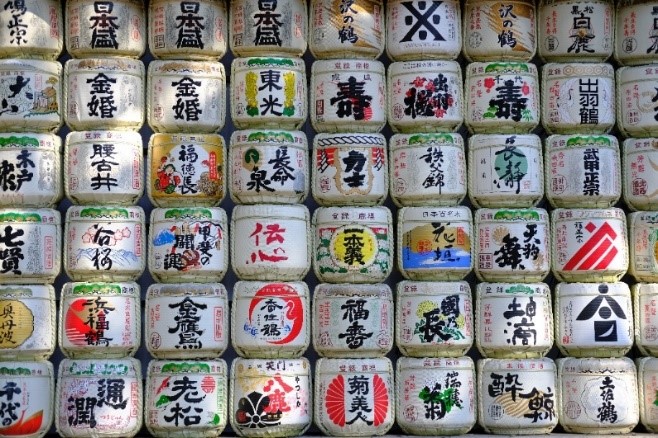
Chinese Green Tea Top 13 Varieties
China is the world’s largest tea producer, generating $91.48 billion in yearly revenue and comprising 47% of the global market. Despite only ranking 20th in tea consumption, Chinese tea plays a significant role in cultural, social, and religious activities. Among many tea varieties produced in China, green tea is the most popular and oldest. Thirteen of the most popular green teas from China, including Chun Mee, Bi Lo Chun, and Da Fang, are described in the article, each having unique flavors and qualities determined by factors such as processing, location, and altitude of the tea tree’s growth.
China ranks as the 20th largest tea-consuming country in the world at 567 grams/1.25 lbs per consumer per year. In contrast, Turkey is the world’s largest tea consumer, with its citizens consuming 3.157 kg/6.96 lbs per person per year! Be that as it may, China’s teas dwarf the rest of the world in tea production, comprising nearly 3.18 million metric tons / 3.5 million tons every year and generating $91.48 billion in yearly revenues. That constitutes 47% of the global market.
Chinese tea consumption began in 2737 BC in Southwest China. As the legend goes, renowned herbalist Emperor Schen Nung, was on a journey crossing the country, and while in the mountains, he stopped to rest under a wild tea tree when one of the leaves fell into his boiling water and changed the color of the water (we now call “steeping”). The emperor was intrigued, so he decided to drink it; he found that it was to his liking. He later experimented with the new drink and found it medicinal. He later convinced the Chinese people to cultivate the plant throughout the country and became the Father of Chinese Tea.
Chinese tea is treated as the national drink and plays a significant role in cultural, social, and religious activities. China is famous for many types of teas, including Black Tea, Oolong, Yellow Tea, Red Tea, Pu’er tea, and various herbal drinks that include many for medicinal purposes. The one we will focus on is perhaps the most popular in China and certainly one of the oldest; Green Tea.
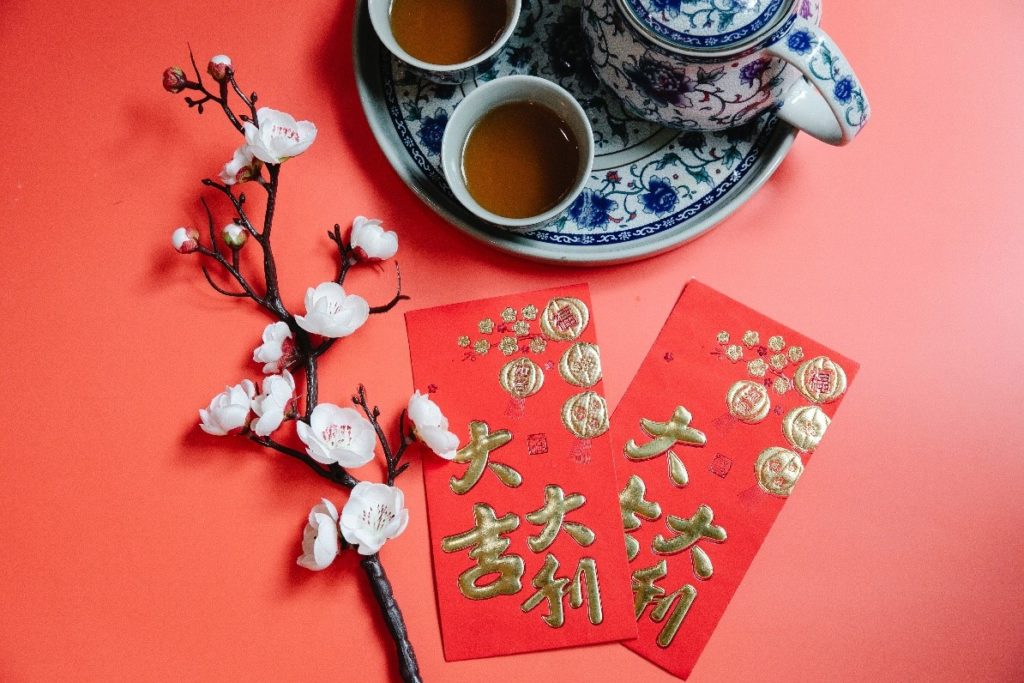
Enjoy a nice cup of Lubba Green Tea! Order here.
Even though all tea comes from the same plant genus, the Camellia Sinensis plant, tea processing renders many different results. For example, the difference between Chinese tea and Japanese green tea has to do with the process, both the growing process and the post-harvest process. Chinese Green Tea is pan-fried to stop oxidation, while Japanese Green Tea is steamed. Pan-fried produces roasted and nutty flavors. Steamed produce grassy, vegetal, and somewhat herbaceous flavors.
Also, the location and altitude of the tea tree’s growth have a verifiable taste difference. Different terrains, having different soils and native vegetation, will influence the flavor and taste. Tea grown at sea level will have a grassy, salty, oceanic, umami flavor compared to tea grown high in the mountains, which takes on malty, earthen, nutty, and sometimes sweet flavors.

List of the Top Chinese Tea Varieties
We will explore 13 Chinese green tea types and their backgrounds. This list is not exhaustive but is meant to explore the more popular green teas coming from China. So here they are, in no particular order.
1. Chun Mee
Chun Mee is sometimes called Zhen Mei, meaning “precious eyebrows.” Has a medium-bodied, bright yellow liquor and has the flavor of charred leeks. It is produced in the Zhejiang, Anhui, and Jiangxi Provinces. Has a “dusty” appearance and is generally more acidic and less sweet than other teas. Has several grades. Some examples are #41022 (highest quality), #4011, #9371, #8147 (mostly broken leaves and stems), #9367, #9366, #3008, or the least quality being called #3009.

2. Bi Lo Chun, or “Pi Lo Chun”
Bi Lo Chun translates to “green snail spring.” Grown in the Dong Ting Mountain region near Lake Tai (or Taihu Lake) in Suzhou, Jiangsu Province, China. The flavor profile is floral, nutty & fruity. Bi Lo Chun is divided into 7 grades according to quality level. They are Supreme, Supreme 1, Grade 1, Grade 2, Grade 3, Chao Qing 1, and Chao Qing 2.
Renowned for its delicate appearance, floral aroma, and taste is somewhat fruity. Bi Lo Chun also boasts showy white hairs at the time of harvest. Chinese tea experts hold this tea in very high regard. Ranked #1 green tea by Tea encyclopedia. Also grown in Zhejiang and Sichuan Provinces, but Bi Lo Chun deriving from the East mountain: Dong Shan, or the West Mountain-Xi Shan in Jiangsu Province is considered the best.
These mountains resemble islands, positioned nearly in the lake’s center. Even though they are considered mountains, the highest peak only reaches a maximum height of 200m/656ft above sea level. The taste of tea from these two areas is said to be more nutty than fruity and smooth, even though Bi Lo Chun is considered one of the strongest green teas in China.
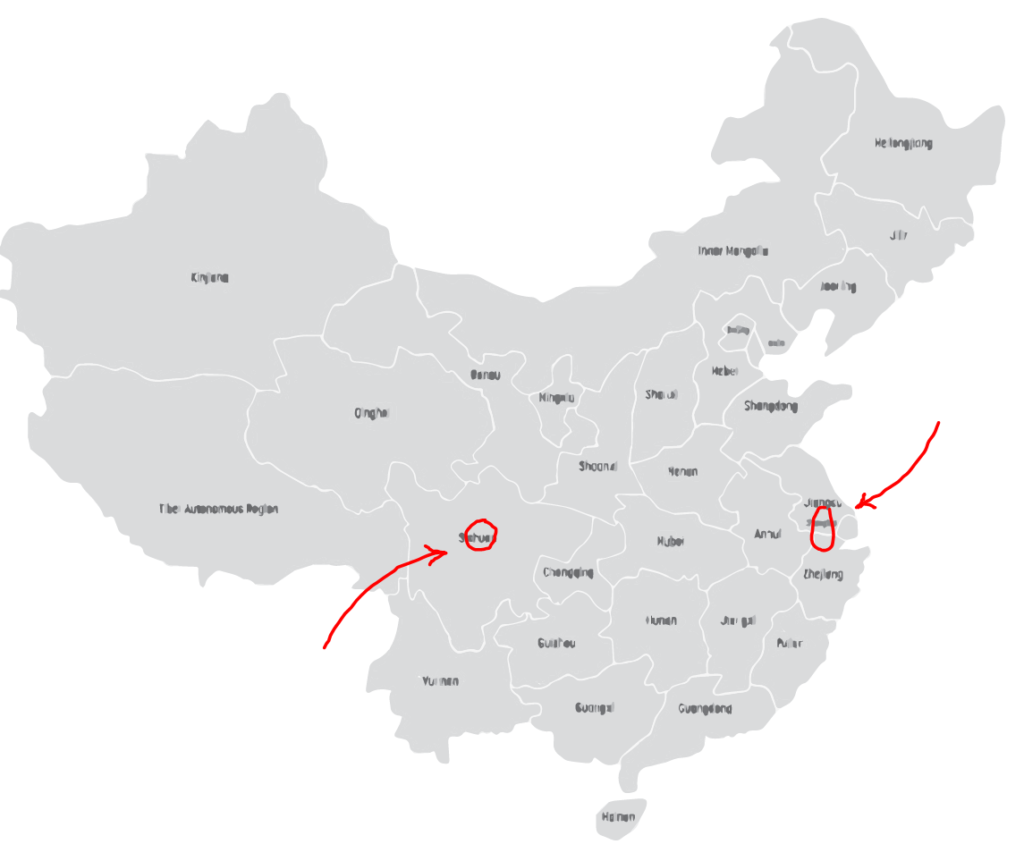
Bi Lo Chun is also grown in northern Taiwan’s Sanxia District of New Taipei City.

3. Da Fang, or “Zhupu Da Fang,” or “Zhuye Da Fang”
Da Fang boasts a sweet and nutty flavor that some say has hints of corn and almonds. Grown at an altitude above 1000m/3300ft. Considered a top-tier tea by tea critics. Has sharp, flat shapes similar to Longjing. Some say it has been around longer than Longjing. It comes in two types based on drying technique: Zhong Huo, which features a nutty aroma, like chestnut, and Qing Huo, which has a more delicate taste.
Named after a Buddhist monk, “Ding Fu Da Fang” in the 13th Century, during the Song Dynasty (10th-13th centuries). It is produced near Lao Zhuling mountain and Fu Guanshan Mountain of She County, Anhui Province.
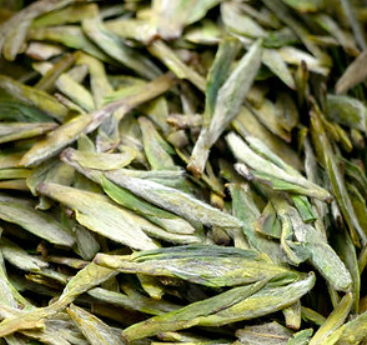
4. Huangshan Maofeng
Huangshan Maofeng is produced in the Southeastern interior of Anhui Province, near where Da Fang is grown and processed. 800m/2600ft. Has a characteristically light color with sweet vegetal notes and a smooth taste. Translates to “Yellow Mountain Fur Peak.” One of the most famous teas in China and can be found just about anywhere. It is a clean, needle-like tea with a slight floral overtone.
It is grown near Huangshan – Yellow Mountain, which is where wide famous varieties of Green Tea are grown. Has small white hairs that cover the leaves. The shape of the processed leaves resembles the peak of a mountain. Picked in the early spring before China’s Qingming festival.
Only the new tea buds and the leaf next to the bud are picked when picking the tea. Local tea farmers say that the leaves resemble orchid buds.

5. Longjing Tea, or “Dragon Well Tea”
“Xi hu Longjing” Ranked this tea second in Tea Cyclopedia. Pan-roasted teas form the area of Longjing Village in Hangzhou, Zhejiang Province. Produced mostly by hand and is renowned for its high quality. Considered very gentle and sweet.
This type of tea has a very high-water content amount and needs more water in the growing cycle than most other tea trees. Known as a common tea, it is consumed by “regular people.” Has six grades: Superior, 1, 2, 3, 4, 5. Granted the status of “Gong Cha,” or imperial tea, in the Qing Dynasty.
The Emperor of Qianlong, while visiting the Hu Gong Temple and drinking tea made from 18 tea trees in front of the temple, was so impressed by Longjing tea that he named these 18 tea bushes special imperial status. These trees are living to this day. The tea harvested from them sells for a price higher than its weight in gold. When stepped, it produces a yellow-green color.
There are five mountain peaks within Xihu (West Lake), all around 200m-300m in height. They ranked according to desirability with these monikers: Lion, Dragon, Cloud, Tiger & Plumb Flower.
6. Mengding Ganlu, or “Ganlu”
Mengding Ganlu is from Meng Mountain in the Sichuan Province, Southwest China. Grown at 900-1200m/2900-3900ft. Means “sweet dew of Mengding.” Aroma and flavoring of orchid and grass. Legend has it that a Toaist Master Wu Lizhen was the first to plant this tea varietal just before the Han Dynasty and during the Ganlu era and wrote about the medicinal qualities of teas from Meng Mountain, which said to “cure any illness.” For 1000 years (Tang to Qing Dynasty), this tea was chosen as a “Tribute Tea” for the emperor’s consumption. Now referred to as tea for the common people.
7. Tai Ping Hou Kui, or “Monkey Tea”
Tai Ping Hou Kui is renowned for its “two knives, one pole,” meant to describe two straight leaves clasping the enormous bud with white colored hairs. Flavoring description varies, but many describe an orchid aroma. The tea shoots can be as long as 15cm/5.9 inches! The leaves are deep green with red veins underneath.
Monkey tea is grown on the Western edge of the Huangshan Mountain, around 600-800m/2000-2600ft in the former Taiping Prefecture, Anhui Province, in a narrow geographical area surrounding three villages. They are Hou Keng, Yan Jia, and Hou Gan Villages. Tai Ping Hou Kui has been grown since the Ming Dynasty and harvested by Emperors.
Authentic Tai Ping Hou Kui must be produced using a specific cultivar called Shi Da Zhong, characterized by these long leaves and strong stems. Teas produced in the surrounding area are called by the same name, cost much less, but are not authentic. False alternatives are rampant.
8. Zhuyeqing, or “Bamboo Shoots”
Zhu Ye Qing tea has a floral aroma and sweet taste and is known for its light golden-green liquor color. Grown at 1500m/4900ft. Heavy fog is common in this growing region, contributing to this tea’s overall quality.
Discovered in 1964 by Foreign Minister General Chen Yi while on a military trip to the region of Mount Emei (one of four sacred Buddhist mountains in China) in the Sichuan Province. While visiting a monastery there, monks offered a unique type of tea to the general, to which he was impressed. He inquired about the name, but when locals said there wasn’t one given, he named it Zhuyeqing because of the resemblance of the leaves to bamboo shoots.
9. Hyson or “Lucky Dragon Tea”
Hyson translates to “flourishing spring.” It is a green tea that comes from the Anhui province of China. Made from young leaves that are thinly rolled to have the appearance of a long, twisted shape that unfurls when steeped. It has a full-bodied, if not pungent, taste that is golden in color. While this isn’t considered an emperor’s tea, the younger shoots are considered higher quality.
Hyson is probably derived from an Amoy (Southern Fujian Province) name meaning “flourishing spring tea” or possibly named after an English tea merchant named Phillip Hyson.
There are three gradations of Hyson: Mi Si, Cheng Si, and Fu Si. Often considered low-grade tea, the young leaves, in contrast, are considered high-quality.
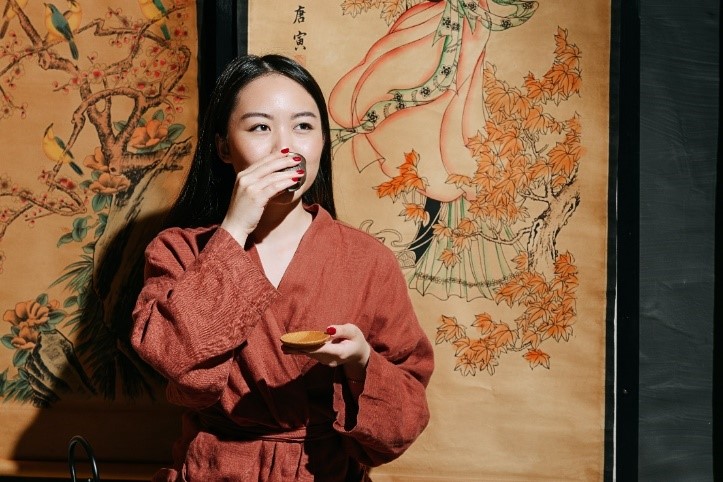
Fun Fact: Hyson tea constituted 70 of the more than 300 chests of tea that were destroyed in the Boston Tea Party in 1773, and Ralph Waldo Emerson in 1847 referenced Hyson by writing: “By fate, not an option, frugal nature gave one scent to hyson and wall-flower, one sound to pine groves and waterfalls, one aspect to the desert and the lake.”
10. Anji Bai, or “Anji White”
These tea leaves are slender, bright green, and delicate looking and are accented with fine white hairs on the underside. The aroma hints at nutty and citrusy. Said to have hints of seaweed with a dry finish.
The liquor is a pale green. Produced in Anji County, Zhejiang Province, and Changxing County, Zhejiang Province. This tea cultivar was discovered in 1982 and is not widely planted. It has a short harvesting period. It is comparatively rare, so it is one of the most expensive teas in China.
11. Baimao Hou
Baimao Hou translates to “white-haired monkey.” The flavor profile denotes sweet and woody characteristics with peppery highlights. Made from the leaves and bud of the green tea leaves during the season’s first two weeks. The leaves have a rather heavy fur coat, making some say they look like monkey paws. Originates from the Taimu Mountains in Fujian Province, around 200m/650ft. It is often mistaken for white tea.
12. Lu’an Melon Seed, or “Lu’an Leaf,” or “Lu’an Guapian Tea”
This green tea produces a bright liquor with a light vegetal aroma. The herbaceous flavor has notes of spinach. Derives from Lu’an City in the Anhui Province at 800m/2600ft. A famous tea and very popular in China. The leaves, which are flat and oval, are said to resemble a melon seed. Uses the second leaf on the branch. It is a baked green tea that produces different flavors than others. Consumed since the Ming Dynasty.
13. Gunpowder, or “Pearl Tea”
Gunpowder tea can be either Green or Oolong. This type is rolled into small round pellets and resembles grains of “gunpowder.” Grown in the Zhejiang Province and Keelung, Taiwan. Tasting notes vary, depending on the location grown. Dates back to the Tang Dynasty. Tea leaves are withered, steamed, rolled, and then dried. Has several grades. 3505AAA is considered the highest grade, while 9375 is a relatively low grade.
When brewing green tea, boil fresh spring water and let cool to ~80 degrees Celsius/175 deg Fahrenheit, then steep for a minute and enjoy. Green tea can be re-infused a few times but requires longer steeping times e¬ach time.
The tea industry began in China, but it isn’t where it ends. We will explore teas from other parts of God’s green tea earth in other postings.

Enjoy a nice cup of Lubba Green Tea! Order here.

Recent Comments